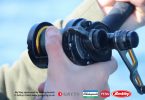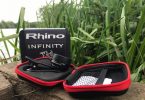The WindPaddle – An Introduction
(section text courtesy of WindPaddle) http://www.WindPaddle.com
The Sail
The WindPaddle sail is made of ½-ounce rip-stop polyester spinnaker sailcloth, the same material used on racing yachts. This material is low-stretch fabric that will not absorb water or become heavy when wet. A large, horizontally-oriented clear window in the center panel of the sail allows for good visibility.
The Sail Seams
All of the seams are sail-taped and sewn using traditional triple-stitch zigzag sail seam construction. A triple-stitch zigzag results in a strong seam where the panels are sewn.
The “Mast”
The sail needs no installation of mast or rig, the windowed sail is supported by a laminated and non-corroding high-modulus yet highly elastic and virtually unbreakable perimeter batten. This batten can be deformed (twisted, bent) yet will still return to its original circular shape. The batten allows the sail to be coiled into thirds (18% of its original size!) for compact stowage and storage.
The “Rigging"
The WindPaddle sail requires no modification to the boat or addition of separate hardware. Nick has designed a clever WindHarness (patent-pending) deck-mounting system that connects the sail to the deck of the boat using existing hardware or deck lines.
Safe & Lightweight
The unique circular design of the WindPaddle keeps the center of effort low for stability, making this the safest small-craft sail available. As wind speed increases, the center of effort remains fixed and doesn’t move up or down. And it’s easy to depower the sail instantly, so you’re always in control. At 13 ounces, the WindPaddle is the lightest weight sail available, and its compact size makes it convenient to slip it in under your deck pack in case you want to use it.
Adventure Sail Physical Dimensions
Deployed diameter – 42" (106.7 cm.) Coiled/folded diameter – 15" (38.1 cm.) Sail area – 9.62 sq. ft. (0.8937 sq. m) Weight – 13 oz. (0.0.368 kg.)
Cruiser Sail Physical Dimensions: Deployed diameter – 56" (142.24 cm.) Coiled/folded diameter – 20" (50 cm.) Sail area – 17.1 sq. ft. (1.589 m²) Weight – 22oz. (0.6237 kg.)
My Review of the WindPaddle
After reading about sails on many kayak fishing & paddling sites and the different models available, I looked around for a lightweight sail which did not need much rigging and time to set up. I came across the WindPaddle on an American site and read many reviews, but these were all from the States. I was curious to find more about the WindPaddle & thought that a UK based review of this product would be of benefit to those of us on this side of the pond. I contacted the inventor of the WindPaddle, Nicholas Mark Wiltz of Hood River, Oregon and ordered (purchased) a WindPaddle Adventure Sail for review. The WindPaddle arrived after about 5 working days. It came neatly packed in a bubble wrapped envelope measuring (approx.) 30" x 24". Inside was the Sail, a DVD and instructions on folding the WindPaddle. Upon opening the envelope I was amazed at how small the sail was folded (coiled) and how light it was. I placed the WindPaddle on the kitchen scales to check the weight. It weighed just a tad under 13oz – slightly lighter than the manufacturers declared weight.

The WindPaddle When Folded (approx. 15")
I tested how easy the WindPaddle was to deploy and fold back down again. This was tried in my front room as I wanted to get the hang of folding before using the sail on the water. Once the compression strap was released the WindPaddle sprung open into a circular shape measuring 42"(top tip: keep the WindPaddle away from your face when you slip off the strap to unfurl the sail!) Then came the folding up of the sail. It took about 2 seconds to fold it up using the figure 8 method which just halves the size of the sail. This method is useful if you need to get the sail folded quickly. However, the proper way of folding (as shown in the instructions which came with the WindPaddle) was a bit harder to master. It took about 10 minutes to get it right. It folds into 3 when done correctly (taking about 5 seconds) and packs down tight with the compression strap slipped over.

The WindPaddle Being Deployed

The WindPaddle folded in half using the figure 8 method
Note: it is a bit bigger than the proper way of folding the sail down but handy if needed to store quickly.
Rigging The WindPaddle
If your kayak has the rope rigged all the way round (anchor trolleys or grab lines) the clips of the WindPaddle can be attached to this or you can connect the clips using existing pad eyes on the kayak if they are in a suitable position. You can fit 2 more pad eyes in a position which would suit where you want the sail. I tried the sail on 2 of my existing pad eyes which were close to my feet. It worked in this position but was better for sailing when fitted to 2 more pad eyes I fitted either side of my front hatch. As is shown in pictures further down. My first task was to fix 2 pad eyes and tie a length of bungee cord between them which holds the WindPaddle when folded and stored.



Once fitted in place the pull cord can be tightened and the button pushed up to lock off the cord. This adjustment ensures the WindPaddle is tight across the bow. If you want to sail across wind,just release the clip and slacken the cord off so the sail has room to maneuver with the wind


The guide lines can either be held in each hand along with your paddle and steered or you can fit cleats and rigging clips to tie the sail off to your deck of the kayak. This is handy for just down wind sailing. I went wi
th the second option,to give myself a choice and for the benefit of the review.

Steering Cord Running Down From The Sail, Through The Rigging & Locked Off By Clam Cleats Either Side

The WindPaddle Is Attached To Factory Fitted Pad Eyes On My Kayak By Clips (not supplied)

Steering cord secured by passing through Clam cleats either side of seating area
Sea Test
The forecast was for 15mph winds gusting to 25mph. These were ideal conditions for testing the sail – With help from SpeciMan (Simon) we fitted the sail to two different kayaks. The Ocean Kayak Scupper Pro TW (without the use of a rudder) and a Dorado (with rudder).


The WindPaddle Folded And Stored On The Dorado

WindPaddle Deployed
As he had a rudder fitted, Simon went for the holding of the steering lines approach – the WindPaddle was attached behind his front hatch.

I went for the set up inline with my front scupper holes at the end of my feet. I was first off. By now the wind had dropped to about 5mph and I was finding it hard to get the sail up, so had to paddle out into Poole bay a bit to find the wind. It seemed every time the sun went behind the clouds the wind picked up. Eventually the wind picked up and we were off.

Raising The Sail To Catch The Wind

Sail Fully Raised – Down Wind Sailing
I found the sail caught the wind very quickly. The WindPaddle was easy to control downwind responding very well. Steering was easy using my paddle and I just sat back and enjoyed the ride.I didn’t feel unstable in the gusts as the sail had a low center of effort. Once in the middle of the Bay I wanted to see how much of a beam reach (cross wind) I could get with no rudder. I was very impressed. I could turn about 65 degrees each way and near enough head across wind at 90 degrees, but think I was being blown a bit down wind whilst the bow was pointing at 90 degrees. All this was done by loosening of the draw string and angling the sail.

I also found the sail spilled the wind easy in sudden gusts which avoided the kayak from tipping. I could manually and instantly depower the sail by releasing the steering cord from the clam cleats and letting the sail collapse onto my front hatch.

Now it was SpeciMan’s turn after the WindPaddle was fitted to his Dorado. At this time the clouds had built up and the wind was blowing at over 10mph with some big gusts thrown in. Simon was steering using his rudder whilst holding the steering cord on the WindPaddle. The Dorado was making good progress and when the wind picked up to over 10mph I could not catch him up, no matter how hard I paddled. The sail also handled a lot better being placed more forward towards the front hatch rather than where I had it placed on the Scupper Pro. The only benefit I could find with it being placed near the end of my feet was the ease of folding and storing the sail. When it was placed further forward you have to shimmy along the deck a bit to reach it. This felt ok in the conditions we tested it in – but might be a bit harder on the open sea in a swell.

Next came the test for going beam reach. The Dorado was making very good progress at going nearly 90 degrees with the sail being angled. As you can see in the next photo’s with the wavelets side on to the Dorado


Storing the sail
Storing the sail was easy on my front hatch under the bungee cord – you could even place it in the front hatch, tankwell or in a large rectangular center hatch. It was even easier on the Dorado as it could be placed in the fish box and the tankwell hatch Simon has fitted.


In The Fish Hatch
Summary
In my view the tests went very well and I was pleased with the performance of the WindPaddle. It was light, easy to use and very quick to rig. The WindPaddle goes across wind (almost 90 degress with a rudder) and was easy to depower. It is excellent for going downwind. That’s what I want a s
ail for. Just for those long trips where I could do with some assistance getting back without rigging the sail on land before I head out. So all in all, it does what its meant to do. The only downsides I found which didn’t really bother me were reaching the sail when it was way forward and when sailing side on sudden gusts caught the sail pushing it back towards me. I suppose you could attach bungee cord to the front carry handle and to the sail to stop it doing this. I didn’t find the need to do this as when you turn, the sail soon picks up again. I tested the WindPaddle Adventure model but there is a larger Cruiser sail available for tandem kayaks and tourers.

Windpaddle Adventure & Cruiser Size Comparision
And, finally a comparison sail chart with other models, taken from the WindPaddle website. Prices vary over here as we are taxed heavily as you can see by the PA model shown in the chart. The WindPaddle is much cheaper in the States.

Review by Mark, a.k.a. Zzippy







